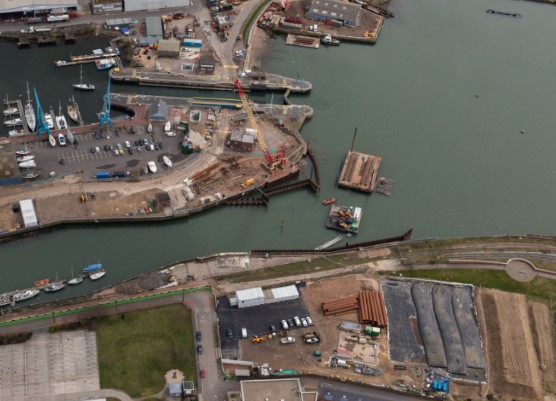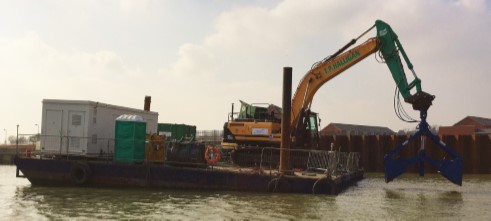
IPSWICH FLOOD DEFENCE MANAGEMENT SCHEME
Our innovation and sustainable approach to the project has resulted in the re-use of material which would generally have been disposed to landfill. In addition, has provided a valuable fill material for a sustainable project for the client, Environment Agency.
Working with Hydrock who was appointed as a sub-contractor to the VBA joint venture who are contracted to build a flood defence system on the River Orwell on behalf of the Environment Agency. Partway through the two year project we have recovered 3,000m3 of silt dredged from the river bed. The material is currently stored in geotextile tubes where it is drying out. The second phase in 2017 requires more material to be removed from the river bed. After which it will be dried ready for re-use.
PROJECT DESCRIPTION
Hydrock was appointed as sub-contractor to the VBA joint venture who have been commissioned to construct a flood defence structure on the lower reaches of the River Orwell where it meets Ipswich docks. The work is part of the Water and Environment Management (WEM) Framework to construct new flood defences at a contract value of £21m. The project includes the construction of a 30m wide tidal barrier gate which is of a similar radial design to those on the Thames Barrier.
Ipswich has a long history of flooding both from high fluvial flows and surge tide effects, with more than 1,500 residential and 400 commercial properties currently within the risk area. The new flood gate will prevent surge tides and allow control of fluvial flow. The scheme involves the construction of piled flood defence walls on either side of the barrier, a control building, the installation of mechanical and electrical equipment, flood gates on the east and west banks within the flood walls, scour protection and landscaping works.
Our involvement in the project was to remove silt from a channel that runs alongside the cofferdam. This channel acts both as a navigation route to a marina upstream of the project, also more importantly was to create a deeper channel which could accommodate the regular storm surges while the barrier is being contracted. In total 3,000m3 of silt was removed from the channel and pumped to the shore using a concrete placement pump. The material was dredged from the river bed using an environmentally friendly clam shell bucket which reduces silt disturbance. The material was pumped into geotextile tubes which allows the material to dewater and dry out. The material has been recorded to be impacted with petroleum hydrocarbons and before it can be reused it needs to be treated to remove future risks to the environment. As part of the work Hydrock has undertaken a bench trial to assess the suitability of stabilising and solidifying the material to remove the risk of contaminants leaching from the soils once they have been placed in their final location.
Once the barrier has been constructed the river will be redirected through the gate and the channel excavated by Hydrock will be closed off using sheet piles. The void created by the sheet pile construction will then be filled using the material recovered by the us, once it has undergone the stabilisation/solidification process. In this process a binder, as proven in the bench trials, will be added to the soils prior to them being placed in the void as a geotechnical fill.
This sustainable solution has meant that the impacted material can be treated on site and then re-used within the final construction of the barrier. The alternative would have been to send the material to landfill and import aggregate to provide fill on the site.
With the project client being the Environment Agency a close eye has been kept on the works both as a client and regulator to ensure that the whole scheme is being delivered in a safe and environmentally conscious manner.

